2004 DAEWOO LACETTI Section 6
[x] Cancel search: Section 6Page 1707 of 2643
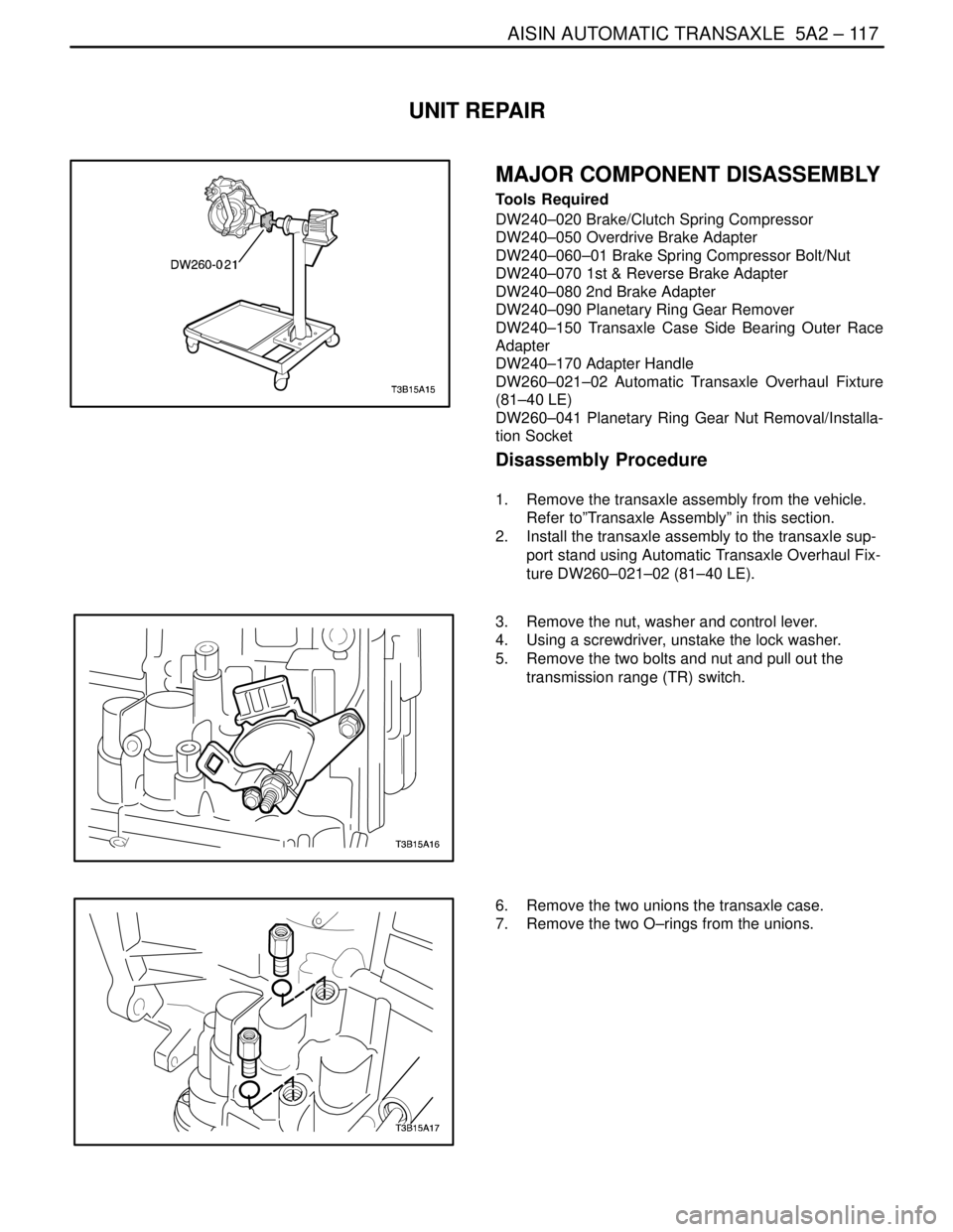
AISIN AUTOMATIC TRANSAXLE 5A2 – 117
DAEWOO V–121 BL4
UNIT REPAIR
MAJOR COMPONENT DISASSEMBLY
Tools Required
DW240–020 Brake/Clutch Spring Compressor
DW240–050 Overdrive Brake Adapter
DW240–060–01 Brake Spring Compressor Bolt/Nut
DW240–070 1st & Reverse Brake Adapter
DW240–080 2nd Brake Adapter
DW240–090 Planetary Ring Gear Remover
DW240–150 Transaxle Case Side Bearing Outer Race
Adapter
DW240–170 Adapter Handle
DW260–021–02 Automatic Transaxle Overhaul Fixture
(81–40 LE)
DW260–041 Planetary Ring Gear Nut Removal/Installa-
tion Socket
Disassembly Procedure
1. Remove the transaxle assembly from the vehicle.
Refer to”Transaxle Assembly” in this section.
2. Install the transaxle assembly to the transaxle sup-
port stand using Automatic Transaxle Overhaul Fix-
ture DW260–021–02 (81–40 LE).
3. Remove the nut, washer and control lever.
4. Using a screwdriver, unstake the lock washer.
5. Remove the two bolts and nut and pull out the
transmission range (TR) switch.
6. Remove the two unions the transaxle case.
7. Remove the two O–rings from the unions.
Page 1825 of 2643

SECTION : 5B
FIVE–SPEED MANUAL TRANSAXLE
CAUTION : Disconnect the negative battery cable before removing or installing any electrical unit or when a tool
or equipment could easily come in contact with exposed electrical terminals. Disconnecting this cable will help
prevent personal injury and damage to the vehicle. The ignition must also be in LOCK unless otherwise noted.
TABLE OF CONTENTS
SPECIFICATIONS5B–2 . . . . . . . . . . . . . . . . . . . . . . . . . .
Fastener Tightening Specifications 5B–2. . . . . . . . . . .
SPECIAL TOOLS5B–3 . . . . . . . . . . . . . . . . . . . . . . . . . . .
Special Tools Table 5B–3. . . . . . . . . . . . . . . . . . . . . . . .
DIAGNOSIS5B–5 . . . . . . . . . . . . . . . . . . . . . . . . . . . . . . . .
Isolate Noise 5B–5. . . . . . . . . . . . . . . . . . . . . . . . . . . . . .
Symptom Diagnosis 5B–6. . . . . . . . . . . . . . . . . . . . . . . .
COMPONENT LOCATORS5B–9 . . . . . . . . . . . . . . . . . .
Gears and Case 5B–9. . . . . . . . . . . . . . . . . . . . . . . . . . .
Bearing Plate 5B–11. . . . . . . . . . . . . . . . . . . . . . . . . . . .
Differential Gear 5B–12. . . . . . . . . . . . . . . . . . . . . . . . . .
Shift Linkage 5B–13. . . . . . . . . . . . . . . . . . . . . . . . . . . . .
MAINTENANCE AND REPAIR5B–15 . . . . . . . . . . . . . .
ON–VEHICLE SERVICE 5B–15. . . . . . . . . . . . . . . . . . . .
Checking Fluid Level 5B–15. . . . . . . . . . . . . . . . . . . . . .
Shift Linkage Adjustment 5B–15. . . . . . . . . . . . . . . . . . Gearshift Lever 5B–17. . . . . . . . . . . . . . . . . . . . . . . . . . .
Gearshift Lever Housing 5B–18. . . . . . . . . . . . . . . . . . .
Speedometer Driven Gear 5B–18. . . . . . . . . . . . . . . . .
Shift Linkage Assembly 5B–19. . . . . . . . . . . . . . . . . . . .
Drive Axle Seal 5B–20. . . . . . . . . . . . . . . . . . . . . . . . . . .
Transaxle Assembly 5B–21. . . . . . . . . . . . . . . . . . . . . . .
UNIT REPAIR 5B–26. . . . . . . . . . . . . . . . . . . . . . . . . . . . .
Major Component Disassembly 5B–26. . . . . . . . . . . . .
Input Shaft and Cluster Gear 5B–35. . . . . . . . . . . . . . .
Mainshaft 5B–37. . . . . . . . . . . . . . . . . . . . . . . . . . . . . . . .
Housing Case 5B–48. . . . . . . . . . . . . . . . . . . . . . . . . . . .
Differential 5B–50. . . . . . . . . . . . . . . . . . . . . . . . . . . . . . .
Major Component Assembly 5B–56. . . . . . . . . . . . . . .
GENERAL DESCRIPTION AND SYSTEM
OPERATION5B–63 . . . . . . . . . . . . . . . . . . . . . . . . . . . . .
Five–Speed Manual Transaxle 5B–63. . . . . . . . . . . . . .
Page 1829 of 2643

FIVE–SPEED MANUAL TRANSAXLE 5B – 5
DAEWOO V–121 BL4
DIAGNOSIS
ISOLATE NOISE
Identify the cause of any noise before attempting to repair
the clutch, the transaxle, or their related link–ages.
Symptoms of trouble with the clutch or the manual trans-
axle include:
S A great effort required to shift gears.
S The sound of gears clashing and grinding.
S Gear blockout.
Any of these conditions requires a careful analysis. Make
the following checks before disassembling the clutch or
the transaxle for repairs.
Road Travel Noise
Many noises that appear to come from the transaxle may
actually originate with other sources such as the:
S Tires.
S Road surfaces.
S Wheel bearings.
S Engine.
S Exhaust system.
These noises may vary according to the:
S Size of the vehicle.
S Type of the vehicle.
S Amount of insulation used in the body of the ve-
hicle.
Transaxle Noise
Transaxle gears, like any mechanical device, are not ab-
solutely quiet and will make some noise during normal op-
eration.
To verify suspected transaxle noises:
1. Select a smooth, level asphalt road to reduce tire
and resonant body noise.
2. Drive the vehicle far enough to warm up all the lu-
bricants thoroughly.
3. Record the speed and the gear range of the trans-
axle when the noise occurs.
4. Check for noises with the vehicle stopped, but with
the engine running.
5. Determine if the noise occurs while the vehicle op-
erates in:
S Drive – under a light acceleration or a heavy
pull.
S Float – maintaining a constant speed with a light
throttle on a level road.
S Coast – with the transaxle in gear and the
throttle partly or fully closed.
S All of the above.
Bearing Noise
Differential Side Bearing Noise
Differential side bearing noise and wheel bearing noise
can be confused easily. Since side bearings are pre–
loaded, a differential side bearing noise should not dimin-
ish much when the differential/transaxle is run with the
wheels off the ground.
Wheel Bearing Noise
Wheel bearings produce a rough growl or grating sound
that will continue when the vehicle is coasting and the
transaxle is in NEUTRAL. Since wheel bearings are not
pre–loaded, a wheel bearing noise should diminish con-
siderably when the wheels are off the ground.
Other Noise
Brinelling
A brinelled bearing causes a ”knock” or ”click” approxi-
mately every second revolution of the wheel because the
bearing rollers do not travel at the same speed as the
wheel. In operation, the effect is characterized by a low–
pitched noise.
A brinelled bearing is caused by excessive thrust which
pushes the balls up on the pathway and creates a triangu-
lar–shaped spot in the bearing race. A brinelled bearing
can also be caused from pressing one race into position
by applying pressure on the other race.
A false indication of a brinelled bearing occurs as a result
of vibration near the area where the bearing is mounted.
Brinelling is identified by slight indentations, resulting in a
washboard effect in the bearing race.
Lapping
Lapped bearing noise occurs when fine particles of abra-
sive materials such as scale, sand, or emery circulate
through the oil in the vehicle, causing the surfaces of the
roller and the race to wear away. Bearings that wear loose
but remain smooth, without spalling or pitting, are the re-
sult of dirty oil.
Locking
Large particles of foreign material wedged between the
roller and the race usually causes one of the races to turn,
creating noise from a locked bearing. Pre–loading regular
taper roller bearings to a value higher than that specified
also can result in locked bearings
Pitting
Pitting on the rolling surface comes from normal wear and
the introduction of foreign materials.
Spalling
Spalled bearings have flaked or pitted rollers or races
caused by an overload or an incorrect assembly that re-
sults in a misalignment, a cocking of bearings, or adjust-
ments that are too tight.
After completing these checks, refer to the ”Diagnosis
Chart” in this section.
Page 1842 of 2643
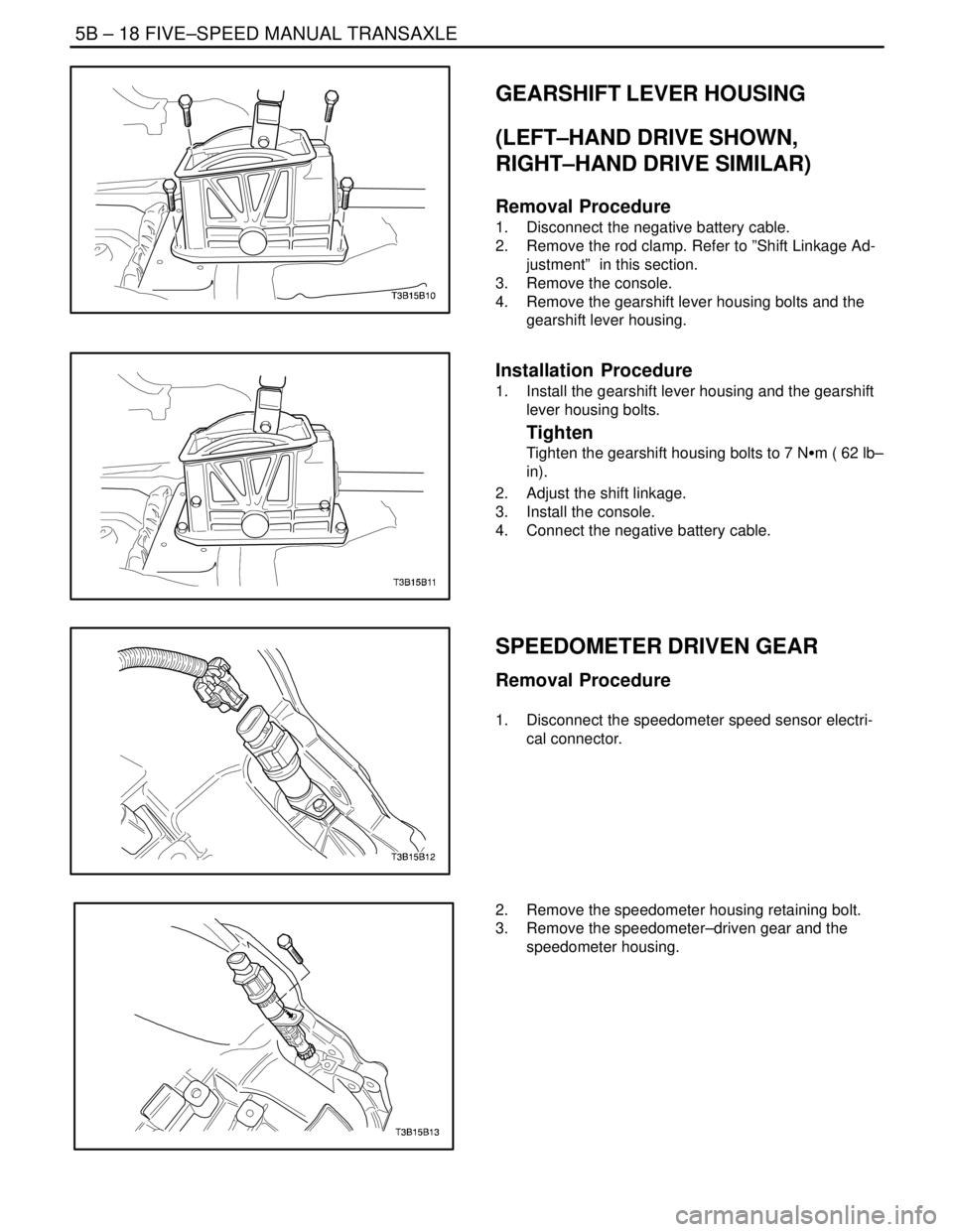
5B – 18IFIVE–SPEED MANUAL TRANSAXLE
DAEWOO V–121 BL4
GEARSHIFT LEVER HOUSING
(LEFT–HAND DRIVE SHOWN,
RIGHT–HAND DRIVE SIMILAR)
Removal Procedure
1. Disconnect the negative battery cable.
2. Remove the rod clamp. Refer to ”Shift Linkage Ad-
justment” in this section.
3. Remove the console.
4. Remove the gearshift lever housing bolts and the
gearshift lever housing.
Installation Procedure
1. Install the gearshift lever housing and the gearshift
lever housing bolts.
Tighten
Tighten the gearshift housing bolts to 7 NSm ( 62 lb–
in).
2. Adjust the shift linkage.
3. Install the console.
4. Connect the negative battery cable.
SPEEDOMETER DRIVEN GEAR
Removal Procedure
1. Disconnect the speedometer speed sensor electri-
cal connector.
2. Remove the speedometer housing retaining bolt.
3. Remove the speedometer–driven gear and the
speedometer housing.
Page 1843 of 2643
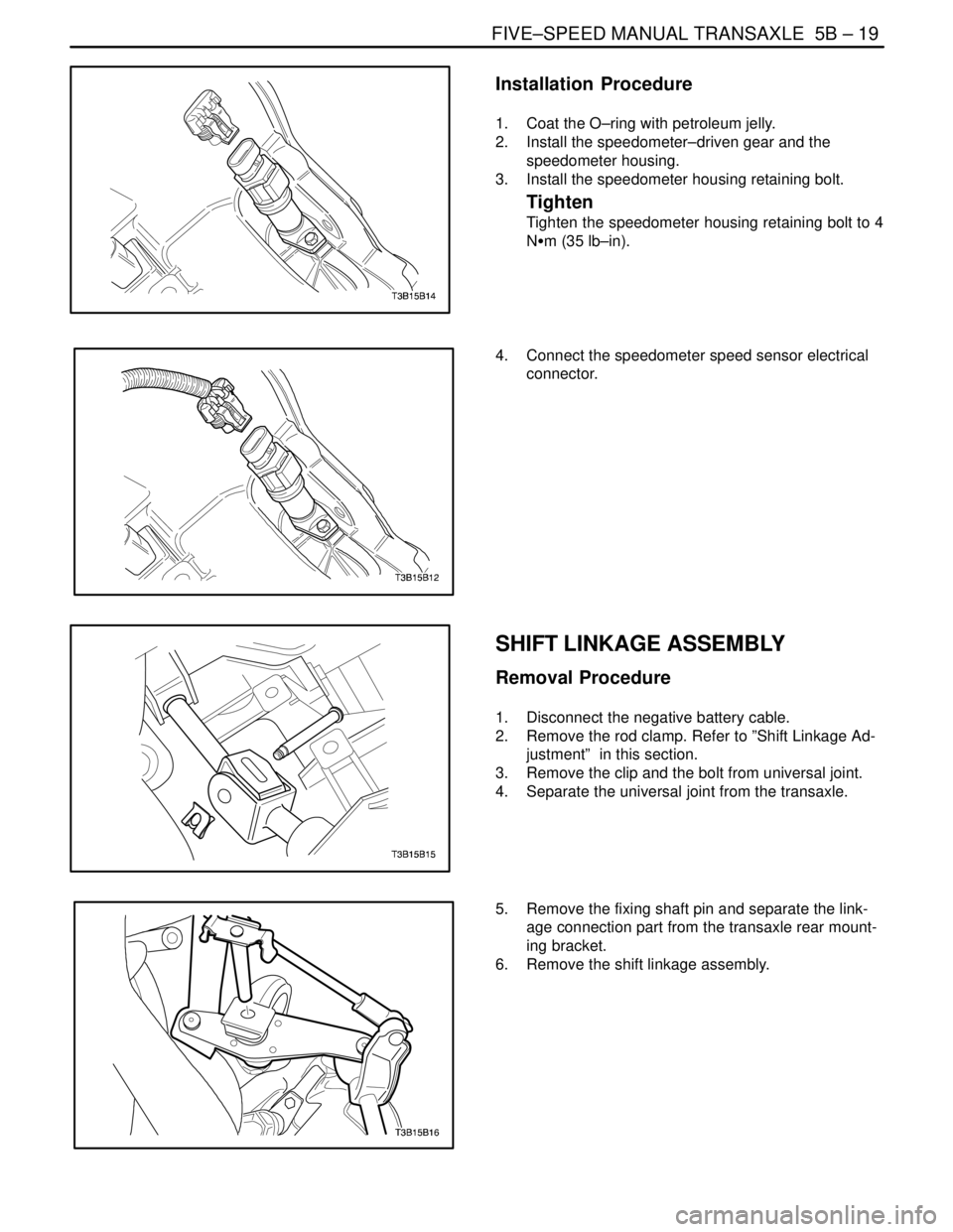
FIVE–SPEED MANUAL TRANSAXLE 5B – 19
DAEWOO V–121 BL4
Installation Procedure
1. Coat the O–ring with petroleum jelly.
2. Install the speedometer–driven gear and the
speedometer housing.
3. Install the speedometer housing retaining bolt.
Tighten
Tighten the speedometer housing retaining bolt to 4
NSm (35 lb–in).
4. Connect the speedometer speed sensor electrical
connector.
SHIFT LINKAGE ASSEMBLY
Removal Procedure
1. Disconnect the negative battery cable.
2. Remove the rod clamp. Refer to ”Shift Linkage Ad-
justment” in this section.
3. Remove the clip and the bolt from universal joint.
4. Separate the universal joint from the transaxle.
5. Remove the fixing shaft pin and separate the link-
age connection part from the transaxle rear mount-
ing bracket.
6. Remove the shift linkage assembly.
Page 1844 of 2643
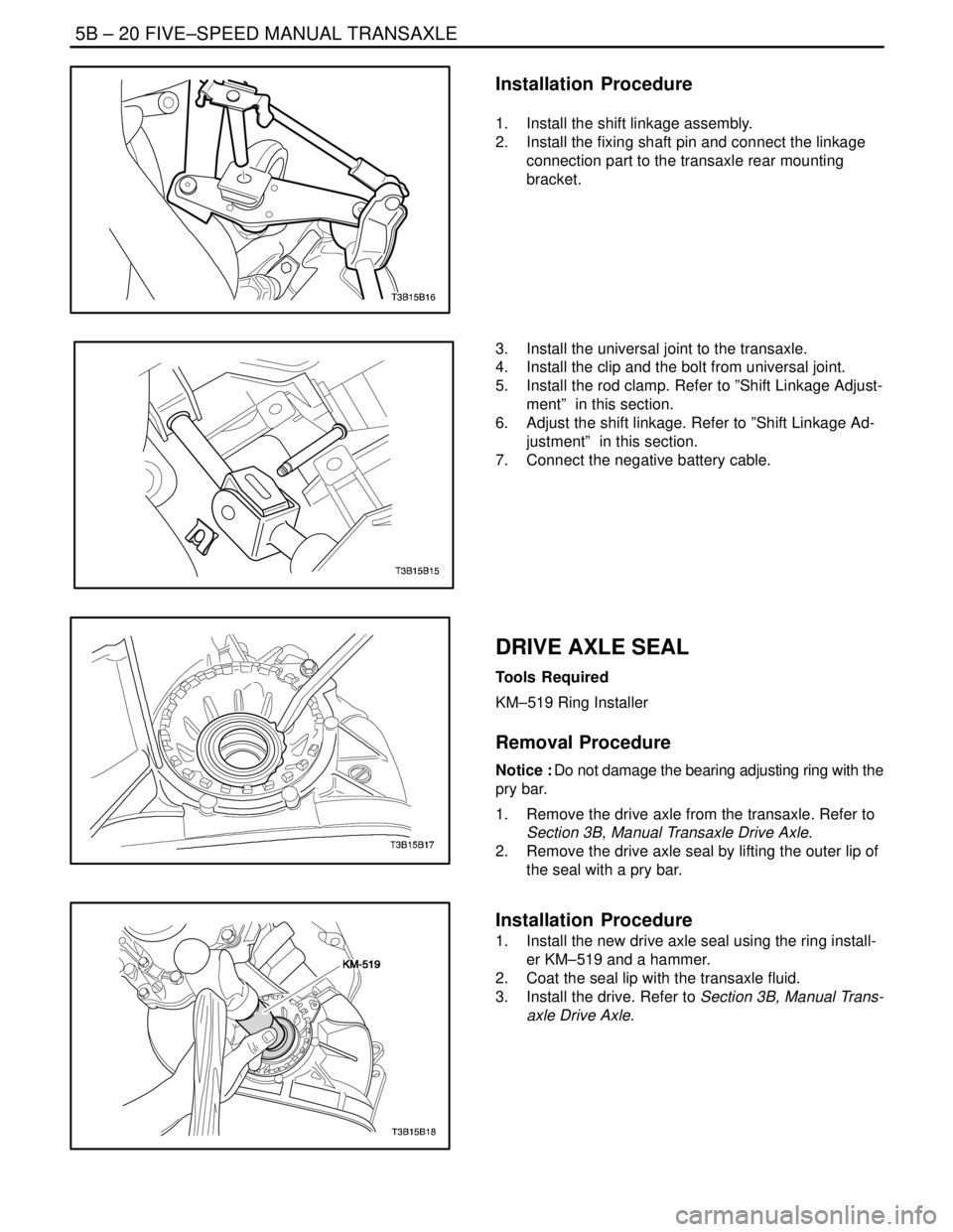
5B – 20IFIVE–SPEED MANUAL TRANSAXLE
DAEWOO V–121 BL4
Installation Procedure
1. Install the shift linkage assembly.
2. Install the fixing shaft pin and connect the linkage
connection part to the transaxle rear mounting
bracket.
3. Install the universal joint to the transaxle.
4. Install the clip and the bolt from universal joint.
5. Install the rod clamp. Refer to ”Shift Linkage Adjust-
ment” in this section.
6. Adjust the shift linkage. Refer to ”Shift Linkage Ad-
justment” in this section.
7. Connect the negative battery cable.
DRIVE AXLE SEAL
Tools Required
KM–519 Ring Installer
Removal Procedure
Notice : Do not damage the bearing adjusting ring with the
pry bar.
1. Remove the drive axle from the transaxle. Refer to
Section 3B, Manual Transaxle Drive Axle.
2. Remove the drive axle seal by lifting the outer lip of
the seal with a pry bar.
Installation Procedure
1. Install the new drive axle seal using the ring install-
er KM–519 and a hammer.
2. Coat the seal lip with the transaxle fluid.
3. Install the drive. Refer to Section 3B, Manual Trans-
axle Drive Axle.
Page 1845 of 2643
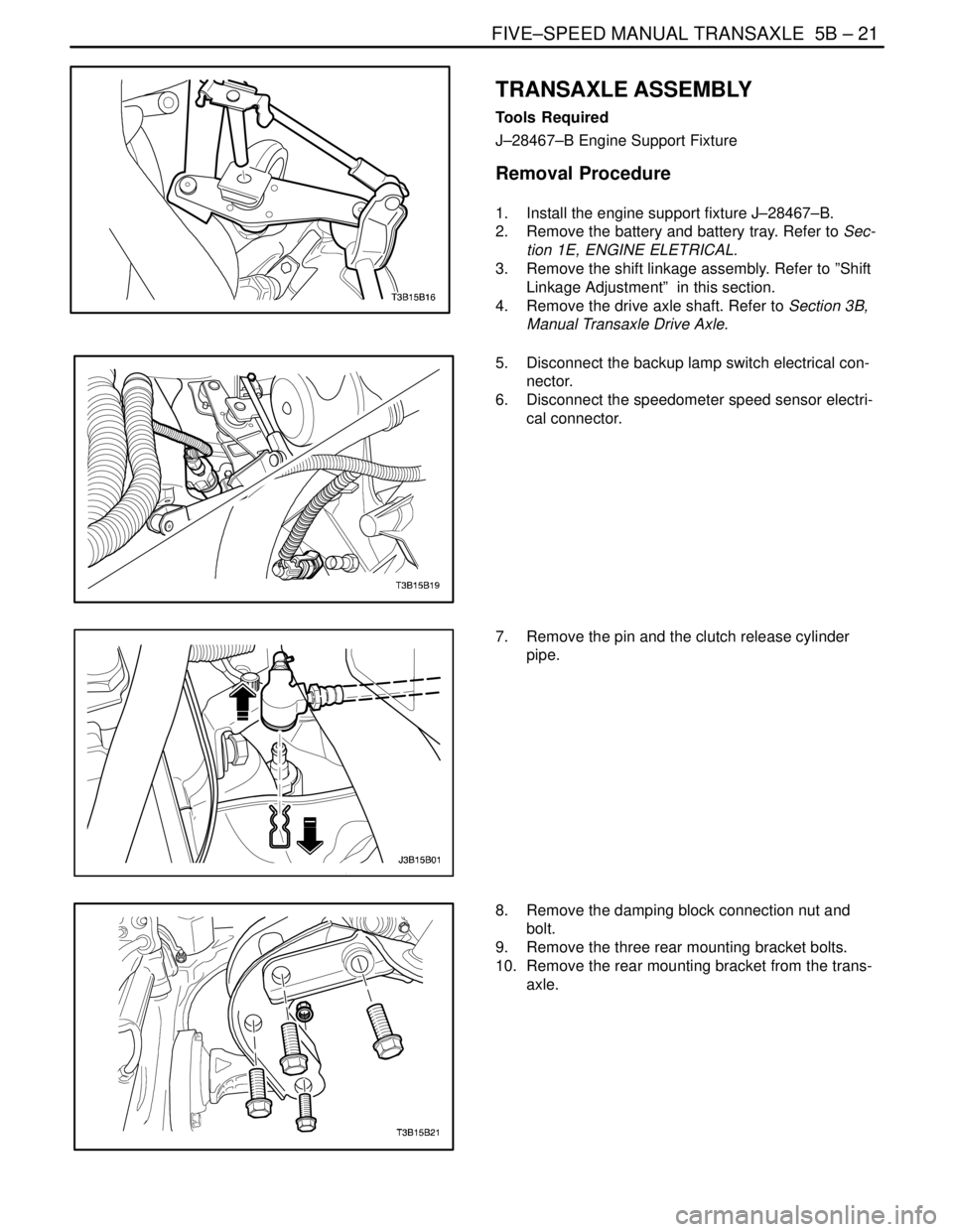
FIVE–SPEED MANUAL TRANSAXLE 5B – 21
DAEWOO V–121 BL4
TRANSAXLE ASSEMBLY
Tools Required
J–28467–B Engine Support Fixture
Removal Procedure
1. Install the engine support fixture J–28467–B.
2. Remove the battery and battery tray. Refer to Sec-
tion 1E, ENGINE ELETRICAL.
3. Remove the shift linkage assembly. Refer to ”Shift
Linkage Adjustment” in this section.
4. Remove the drive axle shaft. Refer to Section 3B,
Manual Transaxle Drive Axle.
5. Disconnect the backup lamp switch electrical con-
nector.
6. Disconnect the speedometer speed sensor electri-
cal connector.
7. Remove the pin and the clutch release cylinder
pipe.
8. Remove the damping block connection nut and
bolt.
9. Remove the three rear mounting bracket bolts.
10. Remove the rear mounting bracket from the trans-
axle.
Page 1849 of 2643
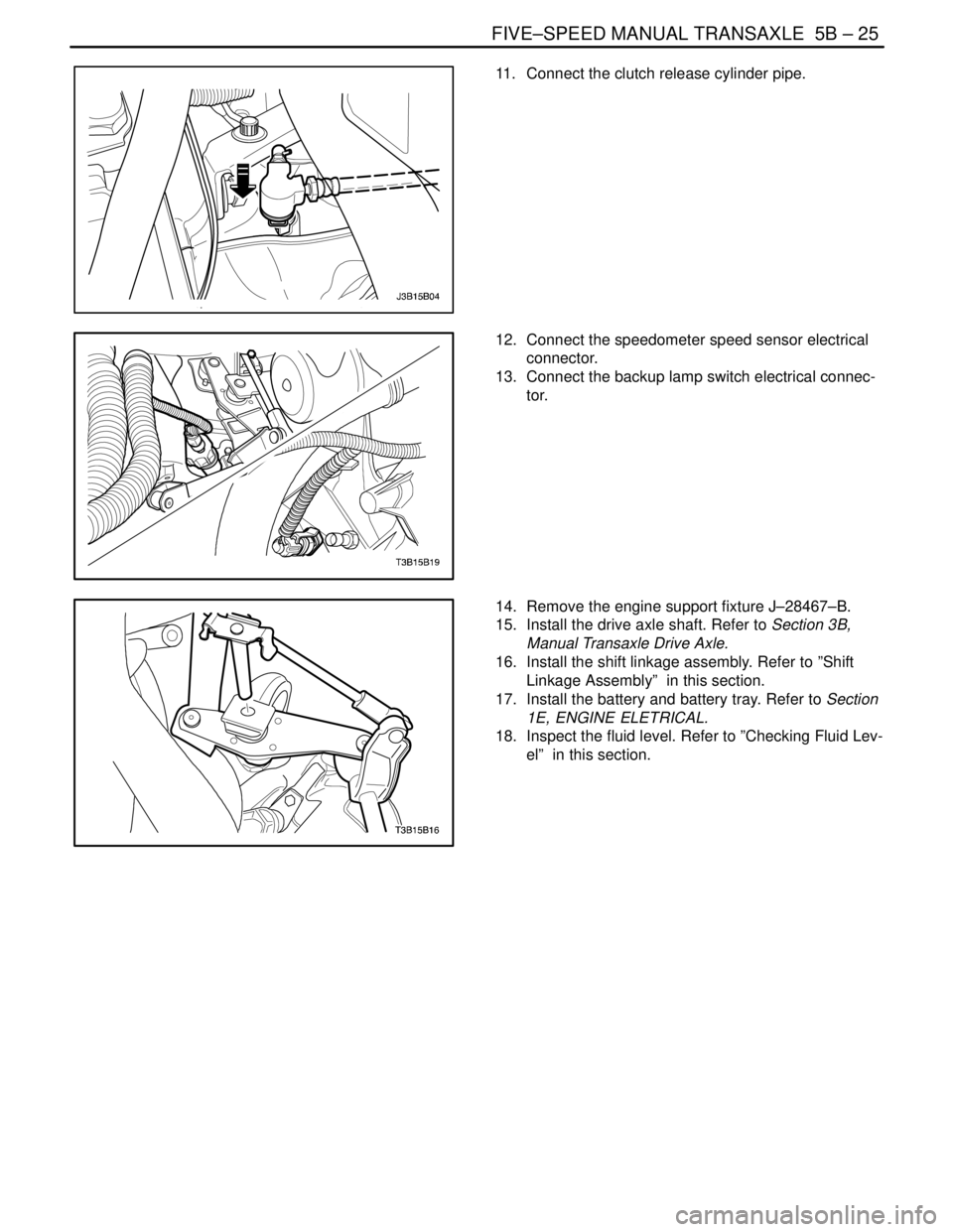
FIVE–SPEED MANUAL TRANSAXLE 5B – 25
DAEWOO V–121 BL4
11. Connect the clutch release cylinder pipe.
12. Connect the speedometer speed sensor electrical
connector.
13. Connect the backup lamp switch electrical connec-
tor.
14. Remove the engine support fixture J–28467–B.
15. Install the drive axle shaft. Refer to Section 3B,
Manual Transaxle Drive Axle.
16. Install the shift linkage assembly. Refer to ”Shift
Linkage Assembly” in this section.
17. Install the battery and battery tray. Refer to Section
1E, ENGINE ELETRICAL.
18. Inspect the fluid level. Refer to ”Checking Fluid Lev-
el” in this section.